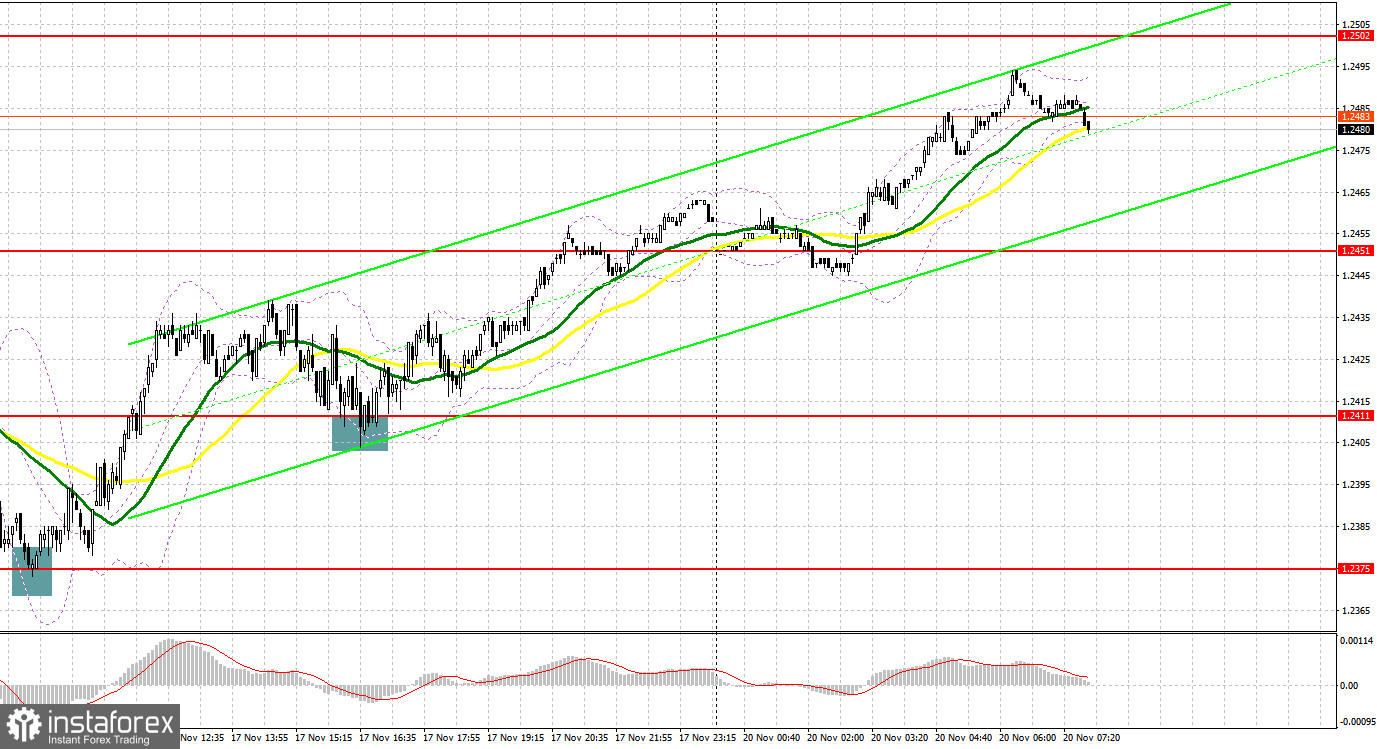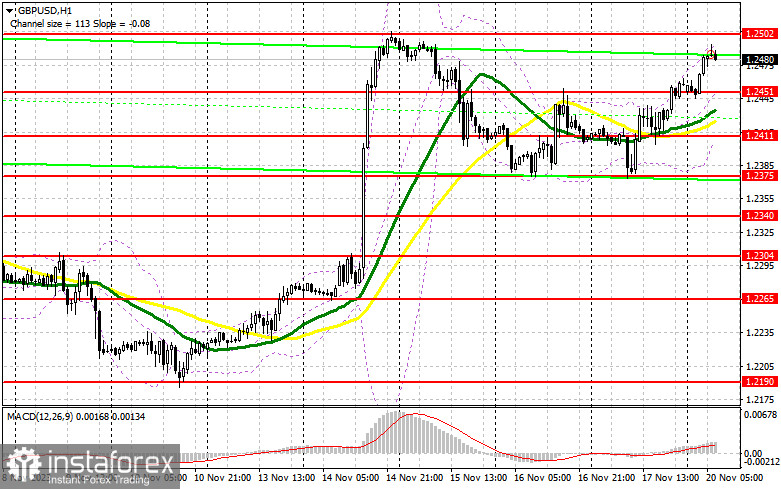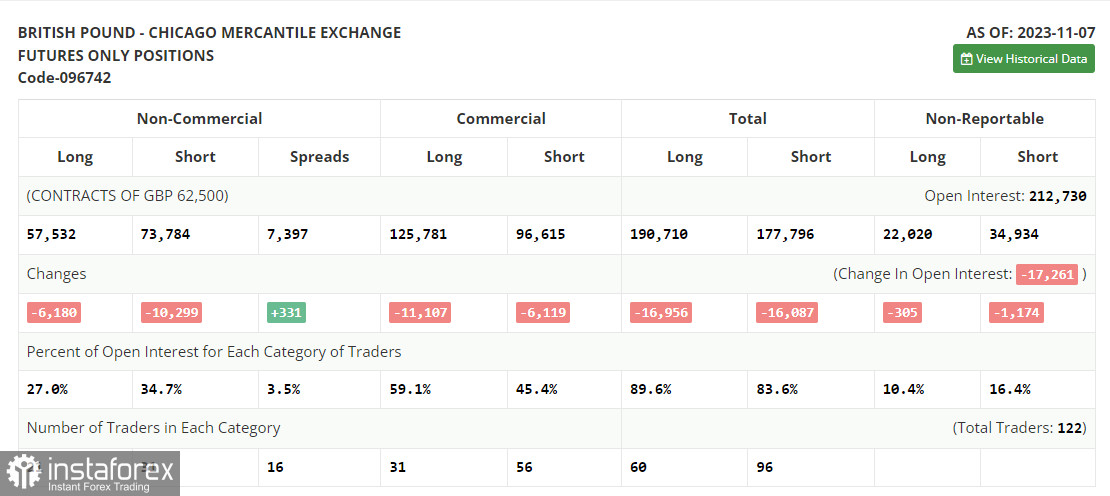Last Friday, the pair formed some great entry signals. Let's have a look at what happened on the 5-minute chart. In my morning review, I mentioned the level of 1.2375 as a possible entry point. A decline and false breakout at this mark produced a buy signal, sending the pair up by more than 60 pips. In the afternoon, a breakout and consolidation above 1.2411 generated another signal. As a result, the pair rose by another 40 pips.

For long positions on GBP/USD:
Today, the pound has a good chance of extending the upward movement, but it needs soft comments from Bank of England Governor Andrew Bailey, as this has recently supported risk assets. In the absence of economic reports during the European session, and if the market reacts to this by exerting pressure on the pair, only a false breakout near the nearest support at 1.2451 will signal market entry into long positions in building an uptrend. The goal is to update this month's high at 1.2502. A breakout and consolidation above this range will produce a buy signal, potentially targeting the 1.2543 area. The ultimate target is found at 1.2581 where I will be taking profits. Should the pair decline and buyers show no initiative at 1.2451, this wouldn't entirely affect the uptrend, but the chances of updating the monthly high will decrease. Only a false breakout near the next support level at 1.2411, which is in line with the moving averages, will signal the opportunity to open long positions. I plan to buy GBP/USD immediately on a rebound from 1.2375, aiming for a correction of 30-35 pips within the day.
For short positions on GBP/USD:
The bears' positions were shaken even more on Friday and today everything will depend on whether they will be active near the monthly high or not. I plan to sell GBP/USD after a false breakout near 1.2502. This will generate a sell signal and the pair could move towards the support level at 1.2451. Below this level, we have the moving averages that favor the bulls. Breaching this level and subsequently retesting it from below will deal a more serious blow to the bulls' positions, lead to a cascade of stop orders, and open a path to 1.2411. The more distant target will be 1.2375, where I'd be taking profits. If GBP/USD grows and there are no bears at 1.2502 in the first half of the day, and it is likely that the bulls will try to continue the uptrend, the trade will move into the new ascending channel. In this case, I will postpone selling until a false breakout at 1.2543. If downward movement stalls there, one can sell the British pound on a bounce from 1.2581, bearing in mind a 30-35-pips downward intraday correction.

COT report:
The Commitments of Traders (COT) report for November 7 showed a decrease in both long and short positions, but this did not significantly alter the market dynamics. Persistent pressure on the pound was observed throughout the week as the latest report on the UK's economic growth rate was disappointing, hinting at the real chances of a recession in Q4 this year. Considering the Bank of England's statements on maintaining high interest rates for an extended period, the chances of a substantial rise in the British pound remain slim. The only factor that could change this dynamic is weak US data indicating a further reduction in price pressures. The more the talks about unchanged US rates in December, the more pressure there will be on the US dollar, making the pound more valuable. The latest COT report states that non-commercial long positions decreased by 6,180 to 57,532, while non-commercial short positions fell by 10,299 to 73,784. Consequently, the spread between long and short positions increased by 310. The weekly closing price rose to 1.2298 from 1.2154.

Indicator signals:
Moving Averages
The instrument is trading above the 30 and 50-day moving averages. It indicates that GBP/USD is likely to rise further.
Please note that the time period and levels of the moving averages are analyzed only for the H1 chart, which differs from the general definition of the classic daily moving averages on the D1 chart.
Bollinger Bands
If GBP/USD declines, the indicator's lower border near 1.2411 will serve as support.
Description of indicators:
• A moving average of a 50-day period determines the current trend by smoothing volatility and noise; marked in yellow on the chart;
• A moving average of a 30-day period determines the current trend by smoothing volatility and noise; marked in green on the chart;
• MACD Indicator (Moving Average Convergence/Divergence) Fast EMA with a 12-day period; Slow EMA with a 26-day period. SMA with a 9-day period;
• Bollinger Bands: 20-day period;
• Non-commercial traders are speculators such as individual traders, hedge funds, and large institutions who use the futures market for speculative purposes and meet certain requirements;
• Long non-commercial positions represent the total number of long positions opened by non-commercial traders;
• Short non-commercial positions represent the total number of short positions opened by non-commercial traders;
• The non-commercial net position is the difference between short and long positions of non-commercial traders.
 English
English 
 Русский
Русский Bahasa Indonesia
Bahasa Indonesia Bahasa Malay
Bahasa Malay ไทย
ไทย Español
Español Deutsch
Deutsch Български
Български Français
Français Tiếng Việt
Tiếng Việt 中文
中文 বাংলা
বাংলা हिन्दी
हिन्दी Čeština
Čeština Українська
Українська Română
Română

